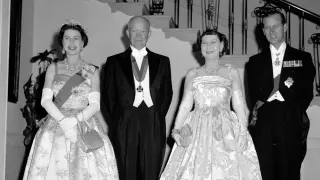December 22, 2021
Saving Saint-Saëns: 'Carnaval des Animaux' and other Works
Tim Pfaff READ TIME: 6 MIN.
For a composer whose work has never gone into eclipse or ever lost the love of musicians and the paying public it enjoyed from the start, Camille Saint-Saëns has gotten a comparatively bad rap. Some critics and music historians –the Paid Opinions– have decreed his work not just facile but superficial.
Allowances have been made for his "serious" works, like the opera Samson et Dalila, offset by the fact that he made his fortune (as many others have since) with The Carnival of the Animals, a children's piece.
December concludes the so-called Saint-Saëns Year, one of those confections of the publicists who in this case celebrate the composer's death centennial. But how few composers could have weathered the year of the pandemic more agilely?
Who knows, 2021 may have marked the nadir of his compositions reaching the concert stage, but recordings –including what will likely become the "reference recording" of Carnaval des Animaux (Linn)– more than took up the slack. Warner Classics saluted the Year with a $100, 34-disc Saint-Saëns edition, containing all the major works in historical and modern recordings. A Saint-Saëns beginner could do far worse.
Eastern-influences
But on disc, a number of rarely heard but important pieces came out to play, chief among them the 1872 one-act, two-character opera, La Princesse jaune (Palazetto Bru Zane), not the first of the composer's dozen-plus worthy operas but the first to have been publicly performed in his lifetime. The recording, nimbly conducted by Leo Hussain, who nails both its verve and its delicacy with the Orchestre National de Capitole de Toulouse, bursts out of the speakers like a star reborn.
It's hard to imagine its being staged today, if only because its title translates to "The Yellow Princess." Saint-Saëns was capitalizing on the contemporary French craze for all things Japanese. The geniunely colorful score, more three-strip Technicolor than French pastel, oozes "Japonaiserie" from its brilliant, whole-tone Overture to its off-stage, all-female chorus, foretelling Puccini's "Madama Butterfly," and affecting "Japanese songs," newly composed and sung, wiltingly, by the principal characters.
The titular Princess, Ming, is represented by a painting in the possession of a Dutch woman named Lena, who has an amorous eye on her cousin, Kornelis, who has an eye for the woman in the painting. Lena catches him red-eyed, barely out of a drug-induced reverie on the painted princess, just in time to shame him into protestations of love for his cousin. Tenor Mathias Vidal's succulent Kornelis plays brilliantly of Judith van Warnroij's acidulous Lena, their interaction as vocally stylish as it is winningly comic.
Americans have never had much time or taste for what Edward Said astutely called "Orientalism," but Europeans have had a sweet tooth for it for centuries, more proud than ashamed of the cultural imperialism at its heart. Though cringe we might at the japonaiserie of "Butterfly," or the chinoiserie of "Turandot," it's a degree harder to look askance at a storyline than prefigures "The Picture of Dorian Gray."
Spears and Daggers
The pharmacology of the "magic philtre" that induces Kornelis' vision is never specified, but the potion fueling the song cycle "Melodies persanes" ("Persian Songs"), which fills out this ingestible disc, is clearly opium, named in the subtitle of the sixth and last song, a peculiarly frenzied depiction of a dizzying opium high. The amorous air of the opium den suffuses all of the brilliantly differentiated songs, which reek even more of the Berlioz of "Les Nuit d'ete."
In "La Solitaire" ("The Lonely Woman") a far saltier sort than we find in Berlioz praises her beloved's "long rifle, spear and dagger" (the sexual metaphors are patent) but more "your eyes with their dark charms, piercing a heart with a single glance."
The 19th-century's "Orient" included the Middle East and northern Africa as well as the Asian continent, the exoticism of the Middle East informing all of "Samson et Dalila." Collectively, the East was the playground of the European monied classes, the men of whom traveled there for, among other pleasures, the easy sexual availability of young men.
It was not happenstance that Saint-Saëns died of a heart attack in Algiers in 1921 at the age of 81. An inveterate traveler to the Mediterranean East for such reasons, he famously protested, "I'm not a homosexual," countering the charge with a defiant, seemingly guilt-free "I'm a pederast."
The bellwether of seriousness in classical music has long been the composition of symphonies, which for most of Saint-Saëns' French counterparts barely constituted a distraction. That makes Warner's new 3-CD release of the composer's Complete Symphonies, with Christian Macelaru leading the Orchestre National de France as significant as it is welcome.
Because the set includes two apprentice and/or incomplete works in addition to the three numbered symphonies, its completeness alone matters. But it's not going too far to claim that these brilliant new recordings will float to the top of the stack without having to elbow their way past earlier contenders.
Dispute all they might his claim to modernity, Saint-Saëns' competitors recognized his consummate craftsmanship, valuing him in the company of Mozart and Mendelssohn in that regard. Anyone still needing to be won over by Saint-Saëns is sure to surrender to the mastery of these new recordings.
Organic
Only No. 3, the "Organ Symphony," has remained in the active repertoire, partly to give big symphony-orchestra organs a gambol in the sunlight. It was customary for the major composers of his day to distinguish themselves as organists as well, a suit Saint-Saëns gloriously followed, proving himself a musician literally to his toenails.
Olivier Latry, peerless in the organ music of Olivier Messaien and others, pulls out the stops for this sonic spectacular, and his finesse makes the most of the subtlety as well as the extravagance of the music, which here sounds absolutely Mahlerian.
For many of you, the must-have Saint-Saëns recording of the year may well be the newly reissued re-master of a CD pairing the Organ Symphony with the rarely heard Fourth Piano Concerto (Harmonia Mundi). It establishes its historical-performance credentials by featuring a stunning 1862 Cavaille-Coll organ in the first and an 1874 Erard piano in the latter. The orchestra, Les Siecles, and their founder and conductor, Francois-Xavier Roth, have since become the toast of the orchestral world. Here's why.
If mind-blowing Saint-Saëns captures your fancy, look no farther than Bru Zane's recording, issued just before the Year, of the opera "Le Timbre d'Argent." It's a piece the composer revised throughout his long career, every measure warranted.
Help keep the Bay Area Reporter going in these tough times. To support local, independent, LGBTQ journalism, consider becoming a BAR member.






